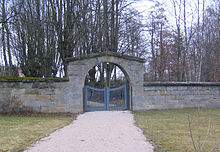Jewish cemetery (Bayreuth)
The Bayreuth Jewish cemetery was founded in 1787 as the burial place of the Jews of Bayreuth , a town in the Bavarian administrative district of Upper Franconia . Today there are about 1000 graves in the cemetery.
history
In the city of Bayreuth, Jewish residents can be traced back to the 13th to the 15th century and then again from 1759. In 1760 a synagogue was established. A separate cemetery for Bayreuth's Jews did not exist until 1787. Before that, the dead were buried in cemeteries in the more or less distant Jewish cemeteries such as Baiersdorf near Erlangen, Burgkunstadt or Aufseß . The first burials took place in the Bayreuth Jewish cemetery in 1786, after the Jewish community had acquired a plot of land well outside of Bayreuth the previous year. The official inauguration took place in 1787.
In 1940, during the National Socialist era , the NSDAP's Gauleitung applied for the closure of the Jewish cemetery. The city administration refused, stating that the city did not own the facility. In 1942 a Jewish-Christian family from Bayreuth was assigned the morgue ( Tahara House ) as an apartment. In 1944, Gauleiter Fritz Wächtler ordered all the stones in the cemetery to be made available for the construction of makeshift homes. The city administration only partially fulfilled this task by removing one or two rows of stones from the cemetery wall. When stones were being removed, some gravestones were willfully overturned. The perpetrator was sentenced to prison in 1947 for desecrating the Jewish cemetery.
Cemetery complex

The cemetery is located on the eastern edge of the city of Bayreuth between Bundesstraße 2 and the Bayreuth-Schnabelwaid railway line on a plot of land that was in the area of the then independent municipality of Oberkonnersreuth when it was first built. The cemetery was expanded several times (1846, 1907 and 2008). Today there are about 1000 graves here.
Graves
The headstones of Jewish graves also changed their appearance over the centuries. The tombstones on the oldest part of the cemetery, which is heavily overgrown with trees, are mostly made of sandstone with Hebrew inscriptions. The 19th century tombstones are mostly made of marble or granite . They are often in the shape of obelisks or pillars . Inscriptions in German increasingly replaced the Hebrew characters. The Star of David can often be found on the newer stones .
Tahara house and memorial
The 19th century cemetery building with the Tahara House , the morgue in which the dead are ritually cleaned before burial, was restored at the end of the 20th century.
50 years after the end of the Second World War , a memorial made up of three pillars was erected next to the Tahara House in 1995 : the left pillar commemorates the Jewish fellow citizens who fell in World War I , the right commemorates the six million Jews who were murdered between 1933 and 1945 were. The middle column bears a text by the prophet Ezekiel .
Graves of important personalities
- Josef Rubinstein : (1847-1884) major pianist , who with Richard Wagner worked
- Kurt de Jonge : The Social Democrat de Jonge was one of the first Bayreuthers to come to the Dachau concentration camp on April 24, 1933 . On May 1st of the same year he was released and went into exile in the Netherlands, from where he would emigrate to Palestine . He returned to Bayreuth in 1954, where he died in 1992.
- Graves of the Würzburger family: Dr. Albert Würzburger ran a private clinic for the mentally ill in Bayreuth. His son Karl Würzburger returned to Bayreuth after the war from exile in Switzerland. Since he converted to Christianity during his exile, he was buried in a non-Jewish cemetery.
literature
- Josef Gothart: What the Bayreuth Jewish Cemetery has to say to us . In: Archive for the History of Upper Franconia , Bayreuth 1998
- Josef Gothart: Beth-le Chajim - House of Life. Bayreuth's Jewish cemetery on Nürnberger Strasse . In: Society for Christian-Jewish Cooperation Bayreuth (ed.): Jüdisches Bayreuth , Bayreuth 2010, pp. 149–160, ISBN 978-3-925361-81-4
- Nathanja Hüttenmeister / Dan Z. Bondy: Examples of Jewish grave culture. The "Good Place" holds over 900 gravestones . In: Society for Christian-Jewish Cooperation Bayreuth (ed.): Jüdisches Bayreuth , Bayreuth 2010, pp. 161–165, ISBN 978-3-925361-81-4
- Israel Schwierz: Stone evidence of Jewish life in Bavaria. A documentation . Ed. from the Bavarian State Center for Political Education . Munich 1988, pp. 210-211, ISBN 3-87052-393-X
- Helmut Paulus: The "Reichskristallnacht" and the persecution of the Jews in the Gau capital Bayreuth . In: Archive for the History of Upper Franconia , Bayreuth 1998
- Jewish Bayreuth - A tour through Jewish Bayreuth, leaflet. Bayreuth 2009
Web links
- Bayreuth Jewish cemetery near Alemannia Judaica
- Bayreuth. In: Overview of all projects for the documentation of Jewish grave inscriptions in the area of the Federal Republic of Germany. Bavaria. Editor: Felicitas Grützmann at the Central Archive for Research into the History of Jews in Germany , 2010
- Digital edition: Bayreuth Jewish Cemetery (1787 to today / 848 inscriptions) of the Salomon Ludwig Steinheim Institute
- Jewish cemeteries in Bavaria - Bayreuth
- The House of Bavarian History on the war memorial in the Jewish cemetery in Bayreuth
Individual evidence
- ↑ Bernd Mayer: Little Bayreuth City History . Pustet, Regensburg 2010, ISBN 978-3-7917-2266-5 , p. 17 .
- ↑ Helmut Paulus: The "Reichskristallnacht" and the persecution of the Jews in the Gau capital Bayreuth
- ^ Björn Mensing: As a Bayreuth Jew and social democrat in the Dachau concentration camp. In: Archive for the history of Upper Franconia, pp. 325–332. 85th volume. Bayreuth 2005.
Coordinates: 49 ° 56 ′ 4 " N , 11 ° 35 ′ 39.8" E





